Article: Role management in PostgreSQL Maestro
Last modified: Sep 1, 2006
Abstract
|
This article discloses the ways of role management provided by PostgreSQL Maestro. Learn how to create, edit, grant and carry out other manipulations with roles with reliable and convenient facility. Due to the simplicity of narration it will be understandable for beginners though the readers are supposed to know the main principles of database management. The attention is placed mainly on practical aspects, so the reader will pass to the general points without spending time on verbose discussions. |
Introduction
The management of database access permissions in PostgreSQL 8.1 is based on the idea of using roles. This idea subsumes the concept of Users and Groups implemented in earlier versions, because a role can be taken as either a database user, or a group of database users, depending on how the role is set up, so we can say that roles erase basic distinctions between users and groups.
Attributes
During the server installation process PostgreSQL creates one predefined role with superuser status. By default it is named as operating system user that initialized the database cluster. So if you want to create more roles you have to connect as this initial role. A number of role attributes is enlarged in comparison with the user attributes. For example to create a new user it was necessary to have a superuser status; now a new additional attribute CREATEROLE is a separate privilege which can be given to any role.
Postgres=# CREATE ROLE admin CREATEROLE;(the role admin can create other roles)
CREATE ROLE
This approach avoids the dangers of operating as a superuser for tasks that do not really require it. Another additional attribute is a Login privilege, only roles that have this attribute can be used as the initial role name for a database connection.
Postgres=# CREATE ROLE staff LOGIN;(the role staff can connect to the server and ready to work with database)
CREATE ROLE
In fact this can simplify the management of access limitations and group privileges. (e.g. you know that some employee is at vacation, to guarantee that no one would connect the database under his role you can void the Login attribute.)
The control over role's attributes in PostgreSQL Maestro is produced as a list of role properties (Picture 1) where you can include or exclude given attributes with a help of usual checkboxes (ticks).
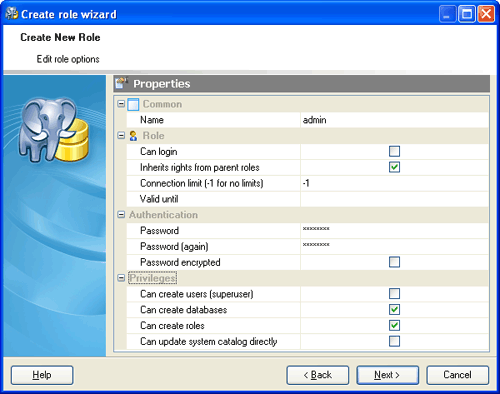
Picture 1. Setting role's attributes.
If something doesn’t fit your conditions you can always adjust settings by means of Role editor (Picture 2),or even by entering an ALTER ROLE statement in the SQL editor.
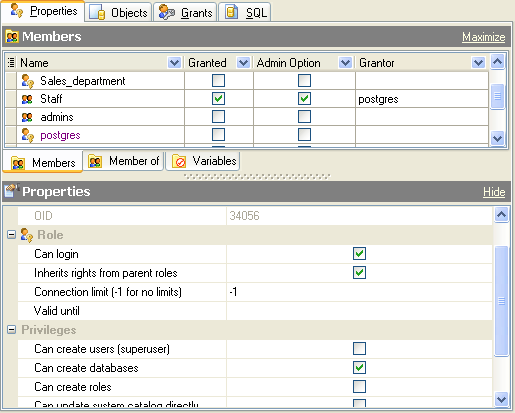
Picture 2. Using Role editor.
Privileges
As an object owner, the role is able to do anything with the object. To allow object manipulating for other roles or specify their activities, the privileges must be granted. Any role may have privileges directly granted to it, privileges of a role it is a member of, and privileges granted to all roles (granted to PUBLIC).
Postgres=# GRANT INSERT ON TABLE postal_address TO PUBLIC;(now all the roles can insert records into table postal_address)
GRANT ROLE
If you want to provide a role (which is not an object owner) with an ability of giving privileges to other roles you have to set a grant option (Picture 3). A distinctive feature of grant option is that it cannot be granted to PUBLIC.
Postgres=# GRANT SELECT ON sales.specialoffer TO admin WITH GRANT OPTION;(role admin has rights to grant SELECT privilege on table sales.specialoffer)
GRANT ROLE
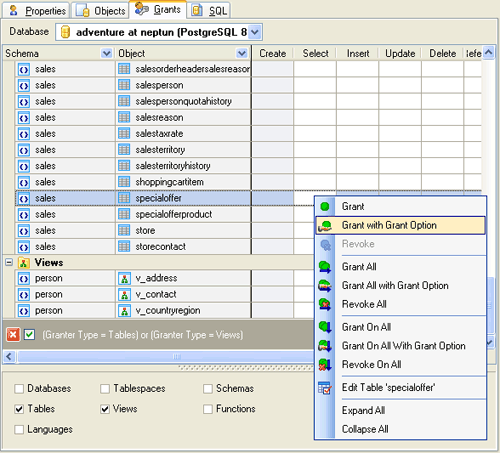
Picture 3. Granting with grant option.
In PostgreSQL Maestro the privileges for one or another database object are represented as a simple table where the possible for a certain object privilege is indicated by the white cell, and unavailable one by the gray cell.
Membership
Any role can act as a user, a group, or both. Roles can own database objects (for example, tables or functions) and can assign privileges on those objects to other roles to control who has access to which objects using the GRANT statement.
Postgres=# GRANT developers TO staff;(role staff is a member of role developers)
GRANT ROLE
PostgreSQL Maestro includes all abilities of PostgreSQL role management. It is possible to grant membership in a role to another role, thus allowing the member role use of privileges assigned to the role it is a member of. The control checkbox in the admin option column is responsible for giving a role the rights to grant membership to others (Picture 4).
Postgres=# GRANT developers TO maintenance WITH ADMIN OPTION;(role maintenance has rights to grant a membership in role developers)
GRANT ROLE
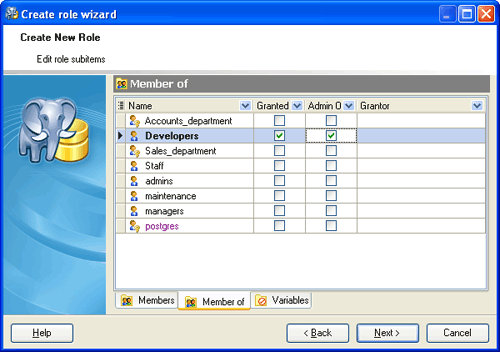
Picture 4. Granting with Admin option.
You can grant membership to other group roles too (since there isn't really any distinction between group roles and non-group roles). The only restriction is that you can't set up circular membership loops. (E.g. group role A containing role B cannot be a member of role B.). Membership rules can be really convenient when designing a tree of your database users especially when their number and privileges are constantly changing.
PostgreSQL Maestro offers you an excellent solution to use all the advantages of the Role concept. Each time you create a new role Maestro gives a list of existing roles where you can choose which of them you would like to add in this new role. At the same time you can make the new role a member of an existing role or leave it completely stand-alone.
A Complex Example
The regulations described above can be set in the psql console. For example we want to create a new role with canlogin, createdb and createrole attributes then limit a number of possible connections, restrict password's validation period, grant a membership in another role to it and overwrite some specific server variables. Taking into consideration that we have already connected to the database the statement will be as follows:
CREATE ROLE maintenance LOGIN VALID UNTIL 'August 31, 2006' CREATEDB CREATEROLE CONNECTION LIMIT 20 ENCRYPTED PASSWORD 'maintenance'; GRANT maintenance TO "Staff" WITH ADMIN OPTION; GRANT admins TO maintenance; ALTER ROLE maintenance SET default_with_oids TO 'on'; ALTER ROLE maintenance SET log_duration TO 'on';
Step1. Select "Create New Role..." in the pop-up menu.
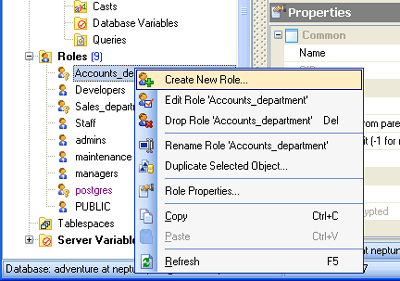
Picture 5.1
Step 2. Set the necessary attributes.
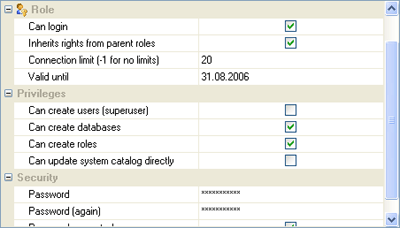
Picture 5.2
Step 3. Set the membership relations with other roles.
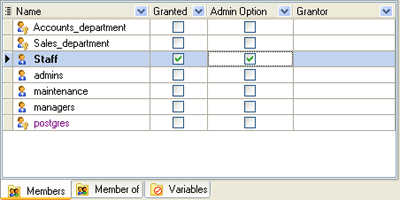
Picture 5.3
Step 4. Customize the environment of the role.
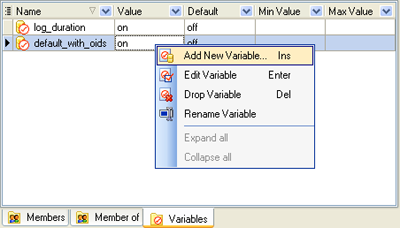
Picture 5.4
Retrieving Information
To make the advantages of PostgreSQL Maestro even more evident we would like to make next examples. Suppose you need to look through the role's privileges for exact database object.
postgres=# z sales.store
Access privileges for database "postgres"
Schema | Name | Type | Access privileges
--------+-------+-------+----------------------------------------------------------------
sales | store | table | {postgres=arwdRxt/postgres,admins=awdRxt/postgres,=r/postgres}
(1 row)
And this is how you can get it by clicking a corresponding table in PostgreSQL Maestro (Picture 6).
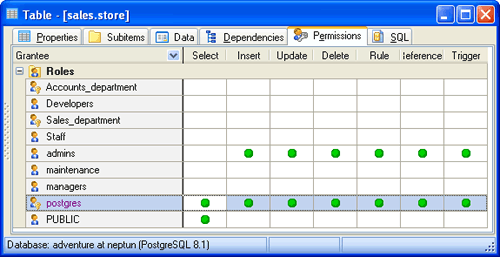
Picture 6. Viewing table permissions.
To retrieve the information about roles attributes and its membership in other roles you may execute the following queries:
SELECT rolname, rolsuper, rolinherit, rolcreaterole, rolcreatedb, rolcanlogin FROM pg_roles;
rolname | rolsuper | rolinherit | rolcreaterole | rolcreatedb | rolcanlogin
---------------------+----------+------------+---------------+-------------+-------------
admins | f | t | f | f | f
Sales_department | f | t | f | f | t
postgres | t | t | t | t | t
Accounts_department | t | t | f | t | t
Developers | f | t | f | f | f
maintenance | f | t | f | t | t
managers | f | t | t | f | f
Staff | f | t | f | f | f
(10 rows)
and
SELECT pg_get_userbyid(member) AS rolename, pg_get_userbyid(roleid) AS name, pg_get_userbyid(grantor) AS grantor, admin_option FROM pg_auth_members WHERE (pg_get_userbyid(member) = 'Staff') ORDER BY name;
rolename | name | grantor | admin_option ----------+-------------+----------+-------------- Staff | Developers | postgres | t Staff | admins | postgres | f Staff | maintenance | postgres | t (3 rows)
To get the same information about a role in PostgreSQL Maestro you just need to click the role name situated in the explorer tree (Picture 7).
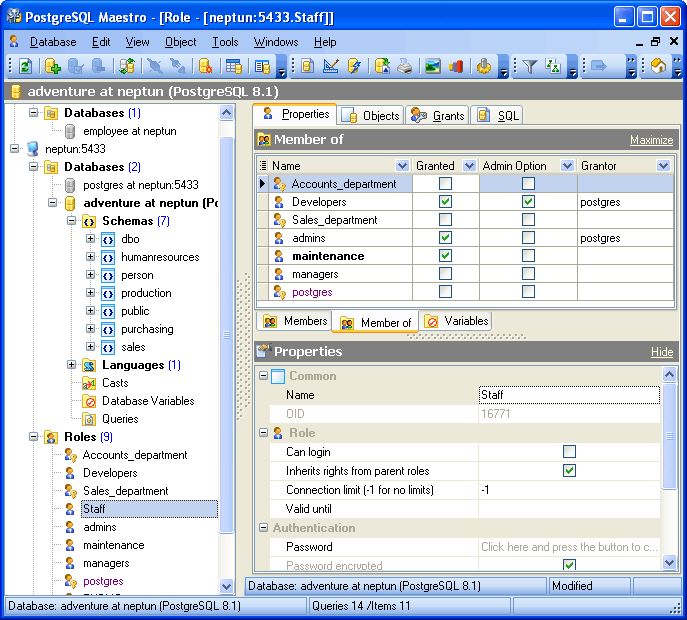
Picture 7. Getting the information about role's attributes and membership.
Means of PostrgeSQL Maestro effectively use all abilities of PostgreSQL. Many of procedures are accessible in a few mouse clicks. If you are looking for a professional interface to work with PostgreSQL, there is no need to keep on searching, because you have found it.
Resources:
- PostgreSQL Maestro home page
- Download free trial version of PostgreSQL Maestro
- Read about roles in PostgreSQL documentation




